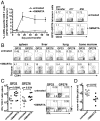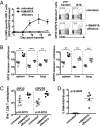Antigen-specific CD4 T-cell help rescues exhausted CD8 T cells during chronic viral infection
- PMID: 22160724
- PMCID: PMC3248546
- DOI: 10.1073/pnas.1118450109
Antigen-specific CD4 T-cell help rescues exhausted CD8 T cells during chronic viral infection
Abstract
CD4 T cells play a critical role in regulating CD8 T-cell responses during chronic viral infection. Several studies in animal models and humans have shown that the absence of CD4 T-cell help results in severe dysfunction of virus-specific CD8 T cells. However, whether function can be restored in already exhausted CD8 T cells by providing CD4 T-cell help at a later time remains unexplored. In this study, we used a mouse model of chronic lymphocytic choriomeningitis virus (LCMV) infection to address this question. Adoptive transfer of LCMV-specific CD4 T cells into chronically infected mice restored proliferation and cytokine production by exhausted virus-specific CD8 T cells and reduced viral burden. Although the transferred CD4 T cells were able to enhance function in exhausted CD8 T cells, these CD4 T cells expressed high levels of the programmed cell death (PD)-1 inhibitory receptor. Blockade of the PD-1 pathway increased the ability of transferred LCMV-specific CD4 T cells to produce effector cytokines, improved rescue of exhausted CD8 T cells, and resulted in a striking reduction in viral load. These results suggest that CD4 T-cell immunotherapy alone or in conjunction with blockade of inhibitory receptors may be a promising approach for treating CD8 T-cell dysfunction in chronic infections and cancer.
Conflict of interest statement
Conflict of interest statement: R.A., A.H.S., and G.J.F. hold patents for the PD-1 inhibitory pathway.
Figures






References
-
- Virgin HW, Wherry EJ, Ahmed R. Redefining chronic viral infection. Cell. 2009;138:30–50. - PubMed
Publication types
MeSH terms
Substances
Grants and funding
LinkOut - more resources
Full Text Sources
Other Literature Sources
Molecular Biology Databases
Research Materials

